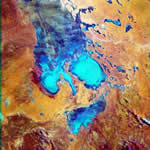
"For only the fourth time this century..."
 |
Myths & Legends
"For only the fourth time this century..." |
In [pick a year] The Lake was full for only the fourth time this century!
It wasn't and Lake Eyre North hasn't been "full" since 1974-76. Full is generally accepted as around 5-6 metres as evidenced by recent geological history. The Lake, given a much wetter era, could fill to a much greater depth before overflowing. It is the remnant of the Inland Sea - Lake Dieri. The Belt - Jackboot Bay basin of Lake Eyre North fills approximately every three years to 1.8 metres as in 1997 and 2000. Refer to the Yachting section for more on the three basins.
The Normally Dry Lake ...
Most years some water reaches the Lake. It's just that the water is either in the middle of a very shallow basin and can't be seen from the shore or is in a part of the Lake that can't be visited easily. When William Creek Hotel publicly advertised Joy Flights to the Lake in 1997 Muloorina Station hadn't seen any water at Level Post Bay - it was in Belt Bay and at 1.8 metres one pilot (Des) was able to run a small punt on it.
Last century (the 20th) tended to show a pattern of at least one basin of the Lake flooded to over 1.5m (navigable) every 3 years, a 3 - 4m flood every 10 years and a "fill" every 25 years.
A Full Lake Influences the Whole of Australia's Weather
No noticeable effects to the whole Australian continent have been documented despite attempts otherwise. However, even when partially full, the Lake does heavily influence the surrounding area. The water in the Lake evaporates rapidly giving increased rainfall to the driest part of Australia. The resultant annual rainfall increase is typically ~125mm or around twice the norm. Observers are correct when they cite that most of the continent is experiencing a wet period when the Lake is full. This is because a large part of the continent has to experience very wet conditions for the Lake to fill!
Further information at The rainfall response to permanent inland water in Australia by Pandora K. Hope and Neville NichollsFilling the Lake Permanently Will Have Beneficial Effects
Various schemes have been proposed to permanently fill the Lake with sea water in an attempt at climate change. When analysed fully these schemes founder on engineering principals concerning the size of channel required and short term results due to the excess amount of salt created in the Lake. Click here for a discussion of the Australian "hydraulic dreaming"
Beware of Kudimudra!
Lake Eyre South is the home of Kudimudra, a bunyip like creature in aboriginal mythology who eats those who stray onto the lake. The Old Ghan Station of Curdimurka is named after the beast and you're bound to see one or two at the Curdimurka Ball!
Let's go for a swim
Most of the time the Lake peaks at a quarter full and so its water is extremely saline. So much so that the salt crust (at around 300mm thick max) often doesn't completely dissolve before the Lake dries again. Swimming in this water, assuming you are prepared to walk through the mud far enough to get to deep enough water, can be extremely painful. The salt will tingle the flesh on your legs but sting severely any mucus membrane parts of your body such as eyes, mouth and some other very intimate parts. This can be particularly painful for women if you think about it! Many a young child has come screaming out of the water. Carry plenty of fresh water (and a camera) to douse the affected area.
Lets Go Fishing
A recent photo in a newspaper centre page spread had a person fishing on the Lake. It was a hoax. While the rivers that feed the Lake are often teeming with fish they are either small (100mm max) salt tolerant species such as the Lake Eyre Hardyhead or larger fresh water varieties that die on entering the saline environment of the Lake. If you wish to fish try the larger rivers in flood at Birdsville or Innamincka for a sporting challenge unless you like very salty sardines!
But what do the pelicans eat? Well that's why they appear in the thousands to wait at the top of the Lake where the fresh water fish become ill/stranded in the very shallow salt water. It's a real smorgasbord!
If you are interested in desert fish species have a look at: